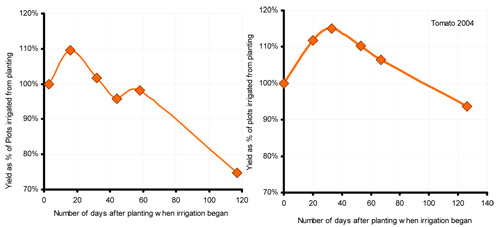Water management in a plasticulture system: What we learned from the okra incident
Vegetables grown in a plasticulture system generally require water applied through a drip system. When this water is applied can have significant effect on plant growth and eventual fruit yield and quality.
Michigan is not known for okra production; however, it does well in a plasticulture system, so I plant it if I have extra space at the end of my trials. Several years ago I had two adjacent okra rows. Three weeks after germination one row was shorter than the other. Investigating why, I reached under the plastic and found no water in the drip tape. Following the tape I found a stake in the tomato trial in the same row had stopped water flow. I moved the tape and restored the flow. After another three weeks the previously short okra had outgrown the other row. What happened?
This sounds like an essay question for a vegetable production exam, but nevertheless, if repeatable and consistent it may present a yield advantage for other vegetables. The working theory we came up with was that since a main root function is looking for water, if they find it easily, root growth slows, and the plant shifts energy elsewhere. While lack of water limited above ground growth, it encouraged root growth. Then, when water was applied, there was greater root area to utilize water and accompanying nutrients, resulting in increased growth.
To test this theory, MSU horticulturalist Mathieu Ngouajio and I designed a trial using peppers and tomatoes. The trial divided plant growth into five stages: Stage 0 (irrigation starting at transplanting), Stage 1 (irrigation starting two weeks after planting), Stage 2 (irrigation starting when vegetative growth began), Stage 3 (irrigation starting at flowering), Stage 4 (irrigation starting at fruit set), and irrigated only to apply weekly nutrients. Beds were shaped and plastic laid when the soil was moist and all treatments were initially irrigated to seal the soil around the roots.
Results of the trial indicated growers could improve tomato yield 15 percent and reduce water use 40 percent by limiting water for three to five weeks after transplanting (Figure 1). We also found an increase in rooting depth for the fertigated-only plots compared to those irrigated since transplanting (47 compared to 35 inches, respectively). Pepper plants in the drier treatments were also noticeably darker green and did have measurably higher chlorophyll levels, suggesting the higher water treatments leached nutrients from the soil or the drier treatments concentrated chlorophyll. Results of the trial can be found in “Irrigation Management for Fresh Market Vegetable Production Using Plasticulture and Drip Systems.”
Figure 1. Relative tomato fruit yield from six irrigation treatments in 2003 (left) and 2004 (right).
Ngouajio et al. Click here to see a larger version
These results suggest that if soil conditions are moist when beds are shaped, it may be possible and beneficial to delay irrigation for several weeks. Doing this could reduce inputs while increasing yield. Growers need to exercise caution when reducing water amounts. It would be good to employ a soil moisture monitoring system to be sure there is adequate soil moisture. Some crops, such as tomatoes, do not quickly show plant wilting. Their response to inadequate water is to produce small fruit and by the time this is observed it is too late for the plants to recover.
Related MSU Extension article: "Double cropping in a plasticulture system"



 Print
Print Email
Email


